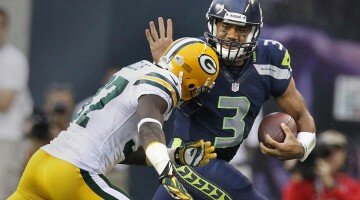Thanksgiving and football are intertwined; backyard games with family, the college and NFL rivalry games ‒ pigskin and turkey go together. But don’t forget that America’s favorite sport has also been plagued by this season by a domestic abuse scandal that is a small part the NFL’s biggest problem – players with brain injuries.
became a sure-fire Hall of Fame football player long before he arrived in New England before the 2006 season. His 20-year professional tenure in the sport remains truly exceptional;  the average NFL career lasts three seasons and very few players have remained active at age 40, with most of those being quarterbacks. Though Seau’s time with the Patriots from 2006 to 2009 clearly showed he was no longer the same player who had earned numerous awards and accolades during his peak years, fans could still bear witness to his tremendous instincts and unbridled passion for the game, as well as the joy he brought to the field.
the average NFL career lasts three seasons and very few players have remained active at age 40, with most of those being quarterbacks. Though Seau’s time with the Patriots from 2006 to 2009 clearly showed he was no longer the same player who had earned numerous awards and accolades during his peak years, fans could still bear witness to his tremendous instincts and unbridled passion for the game, as well as the joy he brought to the field.
Three years after retiring from the NFL, Junior Seau committed suicide. Today his brain tissue resides in a laboratory at the National Institutes of Health, just one more bit of evidence of the dark side of America’s favorite sport. Football players sustain brain injuries and those injuries affect their health, their behavior, and their life span. The gladiators of the gridiron emerge from the tunnel as the finest athletic specimens in the world and leave the field broken and brain-damaged.
The Facts
According to Boston University’s CTE Center, Chronic Traumatic Encephalopathy (CTE) “is a progressive degenerative disease of the brain found in athletes (and others) with a history of repetitive brain trauma, including symptomatic concussions as well as asymptomatic subconcussive hits to the head.” The school’s extensive research has shown that certain compounds, called Tau proteins, build up around blood vessels in the brain, altering nerve function and eventually killing the tissue.
A new test on living patients, positron emission tomography (PET) scanning, illustrates the progressive damage done by CTE to brain cells through the presence of these proteins. While PET scanning has shown promise in limited trials, such as the image below revealing the brain conditions of five retired NFL players, it is not yet considered an acceptably reliable method of CTE assessment:

Until PET or other methods are further developed, there is no definitive means of determining whether a living human being suffers from CTE; a diagnosis is made post-mortem by directly examining cross-sections of brain tissue:

, safety for the Chicago Bears’ vaunted 1985 Super Bowl Shufflers, did not know he suffered from CTE; he simply knew something was wrong with his brain. So when he committed suicide in 2011, he shot himself in the chest and left a note asking that his family donate his brain to science. In the journal Brain, an extensive team of neuroscientists published findings confirming the Boston University CTE Project’s finding that Duerson did, in fact, suffer from CTE at the time of his death.
Scores of football players – ex-NFL and ex-CFB players alike – are living with undiagnosed CTE. For some, like former New England Patriot fullback , a formal diagnosis will come sooner rather than later. Turner also suffers from ALS – Lou Gehrig’s Disease – that has robbed him of the use of his hands and will eventually, as with fellow ex-NFL comrade , take away his ability to walk, to talk, and to breathe. The idea that ex-athletes like Turner and Gleason contracted ALS as a result of repetitive brain trauma is not yet proven according to scientific thresholds, but one does not need to be a neuroscientist to connect the dots – getting hit in the head, repeatedly, does not lead to a long, happy life.
The Lawsuit
 Every few weeks, the latest in the ongoing legal battle between ex-NFL players and owners percolates into the news. Facts are rendered, hands are wrung, and on Saturday and Sunday all of America tunes in for more football. Some players, desperate to deal with mounting medical bills, favor a proposed settlement with the NFL. Others advocate rejecting the league’s settlement offer in order to instead pursue a court verdict. An especially compelling article details the disheartening story of how sick ex-players are being used as “hostages” by the NFL Owners – billionaires who could put in place a system that fairly compensates all their ex-commodities using what amounts to the spare change found in their collective couches.
Every few weeks, the latest in the ongoing legal battle between ex-NFL players and owners percolates into the news. Facts are rendered, hands are wrung, and on Saturday and Sunday all of America tunes in for more football. Some players, desperate to deal with mounting medical bills, favor a proposed settlement with the NFL. Others advocate rejecting the league’s settlement offer in order to instead pursue a court verdict. An especially compelling article details the disheartening story of how sick ex-players are being used as “hostages” by the NFL Owners – billionaires who could put in place a system that fairly compensates all their ex-commodities using what amounts to the spare change found in their collective couches.
By now, nearly every football fan has heard about the lawsuit and names of an ex-player or two affected. The Patriots have Seau and Turner; the Saints have Gleason and (another suicide). The Pittsburgh Steelers have Hall of Famer , the first ex-football player to have a confirmed diagnosis of CTE after his death at age 50 from a combination of self-destructive behavior, steroids, and head trauma. The list of those affected by CTE is too depressing to expand on – remember, to be diagnosed one has to have an autopsy performed, which means one must be dead. Not just debilitated by ALS, or suffering from dementia, or any other number of neurological ailments that afflict ex-football players in a near-epidemic of brain injury and related side effects. Dead.

Earlier this season, a spotlight shone on the NFL’s domestic abuse problem. Players were suspended, league officials were caught lying – it was kind of a mess. But the violent off-field behavior of players toward their partners and/or children isn’t the first issue the NFL has chosen to remain willfully about. Just as domestic abuse was “swept under the rug”, the NFL knew of the “concussion problem” for decades and either misled or lied to players and fans alike. The league’s denial of the problems is the basis of the lawsuit and the near-billion dollar proposed settlement.
The Side Effects
On the list of deceased NFL CTE victims noted earlier, one name that stands apart from the rest: , the ex-Kansas City Chiefs linebacker and former University of Maine Black Bear, murdered the mother of his child in their home and then drove to the team facility where he committed suicide. Belcher was posthumously diagnosed with CTE. He was only 25 years old at the time of his death.
It is understandable that 20 years of NFL play led to Seau’s condition; as a middle linebacker, he initiated and endured thousands of violent collisions. Webster, a center, played for sixteen seasons, knocking heads with defensive linemen on every play. Even Duerson logged ten seasons as a safety, tackling and being hit repeatedly for a decade.

Belcher played just three years as a pro – the league-average career. Yet his brain, like those of the grizzled veterans, showed signs of traumatic injury. Like those veterans, he chose to end his own life. But before doing that, he also chose to murder his girlfriend. And while it cannot be proven, there is clearly reason to suspect that Belcher’s repetitive brain injuries – injuries which have since been identified empirically – contributed to the domestic abuse-turned-murder that ended Kasandra Perkins’ life.
CTE is not a benign affliction; while researchers are able to associate violent behavior with brain injury causally, after-the-fact, there is not yet scientific proof forming a “CTE defense.” Well, unless tries to use it later this year in his murder trial. And perhaps a link will never be proven – it is possible that repetitive traumatic brain injury has nothing to do with violent behavior and domestic abuse. But as these tragedies continue to mount it becomes more difficult for skeptics and those with an agenda to argue that correlation does not equal causation.
The Future
Participation in youth football programs is plummeting. When consulted for this story, my wife responded, “Are you insane?” to the question about whether our 18-month old son might be allowed to play football when he’s older. I do not have a good counter argument.
I love football. The game is endlessly fascinating and there is much to appreciate about it, on and off the field. But change is coming. The NFL and CTE are linked. Junior Seau’s suicide was a gut-punch for fans of the sport everywhere. The irrepressible joy he had on the field is now balanced by the unfathomable sadness that this young, vital man was pushed to suicide, in part, by his injured brain. Jovan Belcher’s murder-suicide was a wake-up call; CTE is not just something that affects players later in life. It isn’t just a precursor to ALS, as for Kevin Turner. CTE is affecting active players, and their families, right now. Repetitive brain injuries are partially to blame for the NFL’s domestic violence crisis, the NFL’s youth football participation problem, and the NFL’s future viability problem.
The end isn’t near; but you can see it from here.
David R. McCullough brings us beyond the plays to the issues shaping the sport, considering the coaches, situations, and players, ruminating on football’s past, and exploring the controversial issues facing the game.
David R. McCullough
Latest posts by David R. McCullough (see all)
- Wilting for Williams: The Race to the First Overall Pick - December 3, 2014
- Week 13 NFL Playoff Picture - December 3, 2014
- Rams Hands Up Protest Shows STLPD Doesn’t Get It - December 2, 2014










No Comment